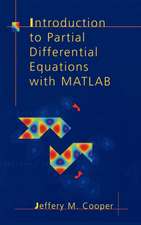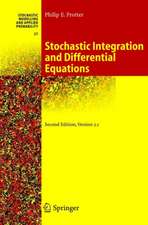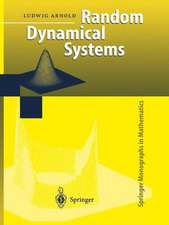Fuchsian Reduction: Applications to Geometry, Cosmology and Mathematical Physics: Progress in Nonlinear Differential Equations and Their Applications, cartea 71
Autor Satyanad Kichenassamyen Limba Engleză Hardback – 18 sep 2007
This work unfolds systematically in four parts, interweaving theory and applications. The case studies examined in Part III illustrate the impact of reduction techniques, and may serve as prototypes for future new applications. In the same spirit, most chapters include a problem section. Background results and solutions to selected problems close the volume.
This book can be used as a text in graduate courses in pure or applied analysis, or as a resource for researchers working with singularities in geometry and mathematical physics.
Din seria Progress in Nonlinear Differential Equations and Their Applications
-
 Preț: 281.13 lei
Preț: 281.13 lei - 15%
 Preț: 643.34 lei
Preț: 643.34 lei - 18%
 Preț: 735.38 lei
Preț: 735.38 lei - 18%
 Preț: 893.40 lei
Preț: 893.40 lei - 18%
 Preț: 1129.99 lei
Preț: 1129.99 lei - 15%
 Preț: 586.23 lei
Preț: 586.23 lei - 18%
 Preț: 1128.57 lei
Preț: 1128.57 lei - 18%
 Preț: 903.21 lei
Preț: 903.21 lei - 18%
 Preț: 788.54 lei
Preț: 788.54 lei - 18%
 Preț: 784.13 lei
Preț: 784.13 lei -
 Preț: 399.12 lei
Preț: 399.12 lei - 15%
 Preț: 640.71 lei
Preț: 640.71 lei - 18%
 Preț: 1012.84 lei
Preț: 1012.84 lei - 18%
 Preț: 1010.17 lei
Preț: 1010.17 lei - 18%
 Preț: 953.97 lei
Preț: 953.97 lei -
 Preț: 383.33 lei
Preț: 383.33 lei - 15%
 Preț: 586.85 lei
Preț: 586.85 lei - 5%
 Preț: 657.34 lei
Preț: 657.34 lei - 15%
 Preț: 635.47 lei
Preț: 635.47 lei -
 Preț: 386.61 lei
Preț: 386.61 lei -
 Preț: 402.56 lei
Preț: 402.56 lei - 15%
 Preț: 704.36 lei
Preț: 704.36 lei - 15%
 Preț: 519.47 lei
Preț: 519.47 lei -
 Preț: 386.00 lei
Preț: 386.00 lei -
 Preț: 391.02 lei
Preț: 391.02 lei -
 Preț: 393.90 lei
Preț: 393.90 lei - 18%
 Preț: 954.93 lei
Preț: 954.93 lei -
 Preț: 387.96 lei
Preț: 387.96 lei - 15%
 Preț: 644.82 lei
Preț: 644.82 lei - 18%
 Preț: 890.37 lei
Preț: 890.37 lei - 15%
 Preț: 642.18 lei
Preț: 642.18 lei -
 Preț: 391.99 lei
Preț: 391.99 lei - 18%
 Preț: 966.15 lei
Preț: 966.15 lei - 18%
 Preț: 789.35 lei
Preț: 789.35 lei
Preț: 394.71 lei
Nou
Puncte Express: 592
Preț estimativ în valută:
75.53€ • 77.92$ • 63.03£
75.53€ • 77.92$ • 63.03£
Carte tipărită la comandă
Livrare economică 26 martie-09 aprilie
Preluare comenzi: 021 569.72.76
Specificații
ISBN-13: 9780817643522
ISBN-10: 0817643524
Pagini: 289
Ilustrații: XV, 289 p.
Dimensiuni: 155 x 235 x 20 mm
Greutate: 0.57 kg
Ediția:2007
Editura: Birkhäuser Boston
Colecția Birkhäuser
Seria Progress in Nonlinear Differential Equations and Their Applications
Locul publicării:Boston, MA, United States
ISBN-10: 0817643524
Pagini: 289
Ilustrații: XV, 289 p.
Dimensiuni: 155 x 235 x 20 mm
Greutate: 0.57 kg
Ediția:2007
Editura: Birkhäuser Boston
Colecția Birkhäuser
Seria Progress in Nonlinear Differential Equations and Their Applications
Locul publicării:Boston, MA, United States
Public țintă
ResearchCuprins
Fuchsian Reduction.- Formal Series.- General Reduction Methods.- Theory of Fuchsian Partial Di?erential Equations.- Convergent Series Solutions of Fuchsian Initial-Value Problems.- Fuchsian Initial-Value Problems in Sobolev Spaces.- Solution of Fuchsian Elliptic Boundary-Value Problems.- Applications.- Applications in Astronomy.- Applications in General Relativity.- Applications in Differential Geometry.- Applications to Nonlinear Waves.- Boundary Blowup for Nonlinear Elliptic Equations.- Background Results.- Distance Function and Hölder Spaces.- Nash–Moser Inverse Function Theorem.
Recenzii
From the reviews:
“Fuchsian reduction is an analytical method to represent solutions to non-linear PDEs near singularities … . The book under review provides a careful and instructive introduction into this method. … At the end of most of the chapters some problems are posed, which are solved in an appendix. In total this is a highly interesting book containing a lot of original ideas and which suggests new developments.” (R. Steinbauer, Monatshefte für Mathematik, Vol. 158 (3), November, 2009)
“Fuchsian reduction is an analytical method to represent solutions to non-linear PDEs near singularities … . The book under review provides a careful and instructive introduction into this method. … At the end of most of the chapters some problems are posed, which are solved in an appendix. In total this is a highly interesting book containing a lot of original ideas and which suggests new developments.” (R. Steinbauer, Monatshefte für Mathematik, Vol. 158 (3), November, 2009)
Textul de pe ultima copertă
Fuchsian reduction is a method for representing solutions of nonlinear PDEs near singularities. The technique has multiple applications including soliton theory, Einstein's equations and cosmology, stellar models, laser collapse, conformal geometry and combustion. Developed in the 1990s for semilinear wave equations, Fuchsian reduction research has grown in response to those problems in pure and applied mathematics where numerical computations fail.
This work unfolds systematically in four parts, interweaving theory and applications. The case studies examined in Part III illustrate the impact of reduction techniques, and may serve as prototypes for future new applications. In the same spirit, most chapters include a problem section. Background results and solutions to selected problems close the volume.
This book can be used as a text in graduate courses in pure or applied analysis, or as a resource for researchers working with singularities in geometry and mathematical physics.
This work unfolds systematically in four parts, interweaving theory and applications. The case studies examined in Part III illustrate the impact of reduction techniques, and may serve as prototypes for future new applications. In the same spirit, most chapters include a problem section. Background results and solutions to selected problems close the volume.
This book can be used as a text in graduate courses in pure or applied analysis, or as a resource for researchers working with singularities in geometry and mathematical physics.
Caracteristici
The applications worked out in Part III may serve as prototypes for use in new applications Can be used as a textbook in graduate courses Problems and bibliographic notes are included















